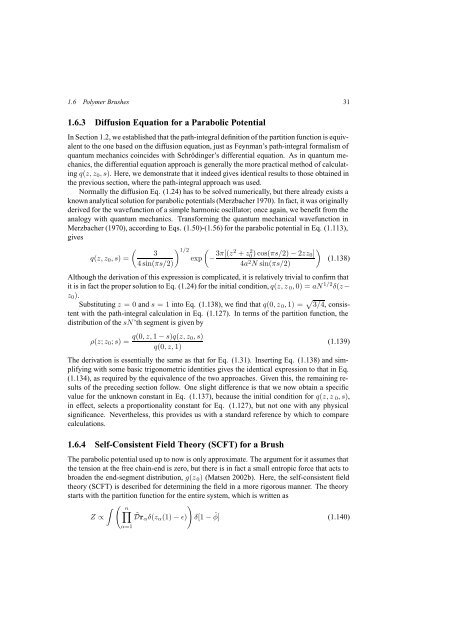Self-Consistent Field Theory and Its Applications by M. W. Matsen
Self-Consistent Field Theory and Its Applications by M. W. Matsen
Self-Consistent Field Theory and Its Applications by M. W. Matsen
Create successful ePaper yourself
Turn your PDF publications into a flip-book with our unique Google optimized e-Paper software.
1.6 Polymer Brushes 31<br />
1.6.3 Diffusion Equation for a Parabolic Potential<br />
In Section 1.2, we established that the path-integral definition of the partition function is equivalent<br />
to the one based on the diffusion equation, just as Feynman’s path-integral formalism of<br />
quantum mechanics coincides with Schrödinger’s differential equation. As in quantum mechanics,<br />
the differential equation approach is generally the more practical method of calculating<br />
q(z,z 0 ,s). Here, we demonstrate that it indeed gives identical results to those obtained in<br />
the previous section, where the path-integral approach was used.<br />
Normally the diffusion Eq. (1.24) has to be solved numerically, but there already exists a<br />
known analytical solution for parabolic potentials (Merzbacher 1970). In fact, it was originally<br />
derived for the wavefunction of a simple harmonic oscillator; once again, we benefit from the<br />
analogy with quantum mechanics. Transforming the quantum mechanical wavefunction in<br />
Merzbacher (1970), according to Eqs. (1.50)-(1.56) for the parabolic potential in Eq. (1.113),<br />
gives<br />
(<br />
q(z,z 0 ,s)=<br />
3<br />
4sin(πs/2)<br />
) 1/2 (<br />
exp − 3π[(z2 + z0 2)cos(πs/2) − 2zz )<br />
0]<br />
4a 2 N sin(πs/2)<br />
(1.138)<br />
Although the derivation of this expression is complicated, it is relatively trivial to confirm that<br />
it is in fact the proper solution to Eq. (1.24) for the initial condition, q(z,z 0 , 0) = aN 1/2 δ(z −<br />
z 0 ).<br />
Substituting z =0<strong>and</strong> s =1into Eq. (1.138), we find that q(0,z 0 , 1) = √ 3/4, consistent<br />
with the path-integral calculation in Eq. (1.127). In terms of the partition function, the<br />
distribution of the sN’th segment is given <strong>by</strong><br />
ρ(z; z 0 ; s) = q(0,z,1 − s)q(z,z 0,s)<br />
(1.139)<br />
q(0,z,1)<br />
The derivation is essentially the same as that for Eq. (1.31). Inserting Eq. (1.138) <strong>and</strong> simplifying<br />
with some basic trigonometric identities gives the identical expression to that in Eq.<br />
(1.134), as required <strong>by</strong> the equivalence of the two approaches. Given this, the remaining results<br />
of the preceding section follow. One slight difference is that we now obtain a specific<br />
value for the unknown constant in Eq. (1.137), because the initial condition for q(z,z 0 ,s),<br />
in effect, selects a proportionality constant for Eq. (1.127), but not one with any physical<br />
significance. Nevertheless, this provides us with a st<strong>and</strong>ard reference <strong>by</strong> which to compare<br />
calculations.<br />
1.6.4 <strong>Self</strong>-<strong>Consistent</strong> <strong>Field</strong> <strong>Theory</strong> (SCFT) for a Brush<br />
The parabolic potential used up to now is only approximate. The argument for it assumes that<br />
the tension at the free chain-end is zero, but there is in fact a small entropic force that acts to<br />
broaden the end-segment distribution, g(z 0 ) (<strong>Matsen</strong> 2002b). Here, the self-consistent field<br />
theory (SCFT) is described for determining the field in a more rigorous manner. The theory<br />
starts with the partition function for the entire system, which is written as<br />
∫ ( )<br />
∏<br />
n<br />
Z ∝ ˜Dr α δ(z α (1) − ɛ) δ[1 − ˆφ] (1.140)<br />
α=1
















